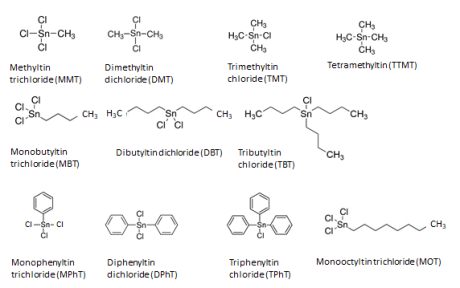A team of German researchers has devised a liquid chromatographic method for separating organotin compounds present in workplace air, utilizing the advanced HPLC-ICP-MS technique to quantify 11 specific organotin species in under 22 minutes.
Background:
Organotin compounds (OTCs) represent a crucial class of organometallic compounds extensively employed in polymer manufacturing as process catalysts and stabilizers, among other applications. At manufacturing facilities, OTCs can be emitted as vapours or dust particles. Due to their considerable toxicity, even at low concentrations, they are subject to wide regulatory oversight, including occupational exposure limits. Given that toxicity varies based on structural characteristics, speciation analysis is imperative for accurate risk assessment. Some OCTs are suspected to be endocrine disruptors. Presently, specific compound-focused workplace exposure monitoring methods are lacking.
Research Objective:
In addressing this gap, a German research group specializing in occupational safety developed a rapid and practical method to detect organotin compounds in workplace air samples.

Figure: Organotin compounds determined by the developed method
The group conducted a comprehensive study on the separation behaviour of 11 OTC compounds using a C18 column and varying mobile phases with solvents of different polarities. Optimization of separation efficacy led to a ternary gradient by initially increasing the overall organic content and then modulating the elution by adjusting the ACN:MeOH ratio. The addition of 0.17% α-tropolone to the aqueous eluent achieved the optimal separation.
Utilizing ICP-MS detection with a cooled spray chamber and oxygen addition to the argon carrier gas, the team achieved detection limits ranging from 0.14 to 0.57 µg Sn/L for the 11 OTCs.
Furthermore, the analysis of compound mixtures is complicated by cross-reactions among different OTCs, resulting in the formation of new compounds. The researchers emphasize that prior to validation and real-world application in workplace air sampling, sample preparation procedures must be meticulously optimized to preserve unstable OTCs.
 The original publication
The original publication

Carina Cläsgens, Tobias Schwank, Katrin Pitzke,
Occupational exposure to organotin substances: Development of a liquid chromatographic separation method for 11 organotin compounds in workplace air samples via HPLC-ICP-MS, J. Chromatogr. A, 1718 (2024) 464695. DOI:
10.1016/j.chroma.2024.464695 Related Studies (newest first):
Related Studies (newest first):

Z. Tian, L. Xing, D. Li, L. Ma, R. Wu, N. Tian, C. Zhang,
Speciation of Tin in Tobacco by High-Performance Liquid Chromatography – Inductively Coupled Plasma – Mass Spectrometry (HPLC-ICP-MS), Anal Lett, 53/15 (2020) 2501-2516,
DOI: 10.1080/00032719.2020.1746325
W. Gui, C. Tian, Q. Sun, S. Li, W. Zhang, J. Tang, G. Zhu,
Simultaneous determination of organotin pesticides by HPLC-ICP-MS and their sorption, desorption, and transformation in freshwater sediments, Water Res., 95 (2016) 185-194,
DOI: 10.1016/j.watres.2016.02.056
D.P. Bishop, D.J. Hare, A. de Grazia, F. Fryer, P.A. Doble,
Speciation and quantification of organotin compounds in sediment and drinking water by isotope dilution liquid chromatography-inductively coupled plasma-mass spectrometry, Anal. Methods, 7/12 (2015) 5012-5018,
DOI: 10.1039/c5ay00555h
Z.-h. Yu, J.-q. Sun, M. Jing, X. Cao, F. Lee, X.-r. Wang,
Determination of total tin and organotin compounds in shellfish by ICP-MS, Food Chem., 119/1 (2010)364-367,
DOI: 10.1016/j.foodchem.2009.05.079

Carol Boraiko, John Batt,
Evaluation of Employee Exposure to Organic Tin Compounds Used as Stabilizers at PVC Processing Facilities, J. Occup. Environ. Hyg., 2/2 (2005) 73-76.
DOI: 10.1080/15459620590906810 R. Wahlen,
R. Wahlen, T. Catterick,
Comparison of different liquid chromatography conditions for the separation and analysis of organotin compounds in mussel and oyster tissue by liquid chromatography-inductively coupled plasma mass spectrometry, J. Chromatogr. B, 783/1 (2003) 221-229,
DOI: 10.1016/s1570-0232(02)00662-1
 Related EVISA Resources
Related EVISA Resources Related EVISA News (newest first) :
Related EVISA News (newest first) :
 June 5, 2009: EU bans certain organotin compounds
June 5, 2009: EU bans certain organotin compounds November 12, 2008: Mechanism of immuno toxicity of dibutyltin clarified
November 12, 2008: Mechanism of immuno toxicity of dibutyltin clarified November 5, 2008: Tributyltin added to U.N. trade watch list
November 5, 2008: Tributyltin added to U.N. trade watch list
 September 18, 2008: REACH Update: List of 300 chemicals of very high concern
September 18, 2008: REACH Update: List of 300 chemicals of very high concern September 18, 2008: Tributyltin canned
September 18, 2008: Tributyltin canned
 June 21, 2008: TBT and other Persistent Man-Made Chemical Pollutants Found in Deep-Sea Octopods and Squids
June 21, 2008: TBT and other Persistent Man-Made Chemical Pollutants Found in Deep-Sea Octopods and Squids
 June 5, 2008: Organotin ban in hull paint begins in September
June 5, 2008: Organotin ban in hull paint begins in September  April 30, 2008: Human exposure to organotin compounds via consumption of fish
April 30, 2008: Human exposure to organotin compounds via consumption of fish September 20, 2007: TBT-ban convention ratified
September 20, 2007: TBT-ban convention ratified
 October 11, 2006: TBT from antifouling paint is still endangering marine life, says WWF ( 11.10.2006 )
October 11, 2006: TBT from antifouling paint is still endangering marine life, says WWF ( 11.10.2006 )
last time modified: September 18, 2024